Award winning dermatology service, with over 20 years on experience
Short waiting lists, on some occasions offering same week appointments
Safe environment, in Care Quality Commission approved facilities
Actinic Keratoses Treatments Include:
actinic keratosis treatment IN CANTERBURY AND KENT UK
Actinic keratoses, also known as solar keratosis, sunspots, sun damage are ill-defined rough patches, ranging in colour from pink to brown and measuring from 0.5 to 3cm in width. Some can resemble crusty outgrowths when they are particularly thick and raised.
If an AK starts to bleed or rapidly change in appearance or size this may indicate that it is progressing toward squamous cell carcinoma and medical advice must be sought immediately.
Actinic keratoses are usually harmless, though they can be itchy and feel rough to the touch. Some people also find their appearance unsightly, particularly when they are on the face.
Alternative names: solar keratosis, sunspots, sun damage.
WHAT DOES ACTINIC KERATOSES LOOK LIKE?
Actinic keratoses are ill-defined rough patches, ranging in colour from pink to brown and measuring from 0.5 to 3cm in width (see figure). Some can resemble crusty outgrowths when they are particularly thick and raised.
If an AK starts to bleed or rapidly change in appearance or size this may indicate that it is progressing toward squamous cell carcinoma and medical advice must be sought immediately.
What are the symptoms of Actinic Keratoses?
It can sometimes be hard to tell if you have actinic keratoses so it is worth checking with a consultant dermatologist if you are worried. Patches of actinic keratoses are usually rough to touch and range in colour from pink to brown. They can measure anywhere between 5mm and 30mm in width and can be thick and raised from the skin. They are often sore or itchy. If an area of your skin which resembles these characteristics starts to bleed, hurt or rapidly change in appearance or size, this may indicate that it is progressing toward squamous cell carcinoma, a form of skin cancer, and must be assessed by a consultant dermatologist as soon as possible. View actinic keratoses images below.
actinic keratoses images:
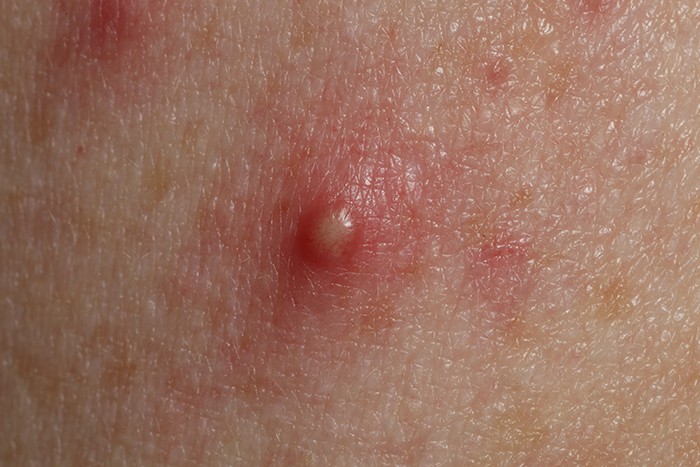
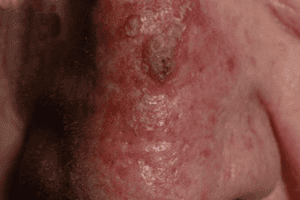
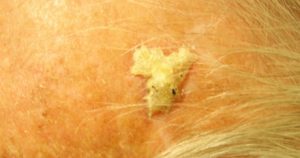
How can Actinic Keratoses be treated?
Actinic keratoses are usually little cause for concern, and small patches may regress by themselves. However, it is important to adopt good sun-protection habits such as using sunscreens and wearing protective clothing on hot days, in order to prevent further skin damage.
Due to the small risk of progression to skin cancer it is generally advisable to treat actinic keratoses. They can also be removed to improve the cosmetic appearance of the skin as a matter of personal choice. A variety of treatments are available and include:
- Creams and ointments (5-fluorouracil, imiquimod or diclofenac sodium): these can be used when there are a large number of actinic keratoses, for example on the scalp.
- Photodynamic therapy: employs the use of a special cream, which is applied to affected areas and is activated by light of a specific wavelength.
- Cryotherapy: involves freezing an affected site with liquid nitrogen.
- Curettage or excision: this is performed under local anaesthetic and normally reserved for thicker patches and suspected skin cancers.
Though these options are highly effective, due to prior sun-damage it is likely that more actinic keratoses will develop in the surrounding skin, requiring future treatment.
Our Dermatologists at the Harley Street Dermatology Clinic can offer effective treatment for all types of sun damage including actinic keratoses.
Frequently Asked Questions
DOES ACTINIC KERATOSIS TURN INTO SKIN CANCER?
Actinic Keratoses are not life-threatening themselves and small patches may disappear on their own but some actinic keratoses can turn into squamous cell skin cancer so can be considered as precancerous. If they are found and treated early, they do not have the chance to develop into skin cancer.
WHAT DO PATCHES OF ACTINIC KERATOSES LOOK LIKE?
The patches can feel like sandpaper, they are dry rough and scaly. They usually range in size from 1cm to 2cm and can be itchy. They can either be the same colour as your skin, pink, red or brown.
WHERE ON THE BODY DO ACTINIC KERATOSIS USUALLY APPEAR?
As the patches of actinic keratosis are caused by exposure to the sun, they are most commonly found on areas of the body which are exposed to the sun such as the face, hands, arms, legs, ears and scalp.
WHAT CAN I DO IF I HAVE ACTINIC KERATOSIS?
If you have patches of actinic keratoses, it is important to get them checked by a dermatologist to reduce the risk of them developing in to skin cancer. To stop getting further patches and to look after your skin it is important to
- use sun cream before exposing your skin to the sun
- wear clothing which will protect your skin from the sun
- do not use sunbeds or sunlamps
- avoid the sun when it is at it’s strongest (between 11am and 3pm)
HOW CAN ACTINIC KERATOSES BE PREVENTED?
Actinic keratoses are usually little cause for concern. Small patches may disappear by themselves. However, it is important to adopt good sun-protection habits.
As actinic keratoses are caused by exposure to the sun, the key to prevention is avoiding the sun when its rays are most intense, especially around the middle of the day. Before going outdoors follow the usual sun safety measures of applying sunscreen with a high SPF and protection from both UVA and UVB light and wearing clothes designed to provide sun protection. It is also important to follow these steps if you already have signs of actinic keratoses in order to reduce the chances of them developing into skin cancer.
REQUEST A CALL BACK
Please fill in this form and one of our team will give you a call back to arrange a consultation with one of our expert dermatologists.
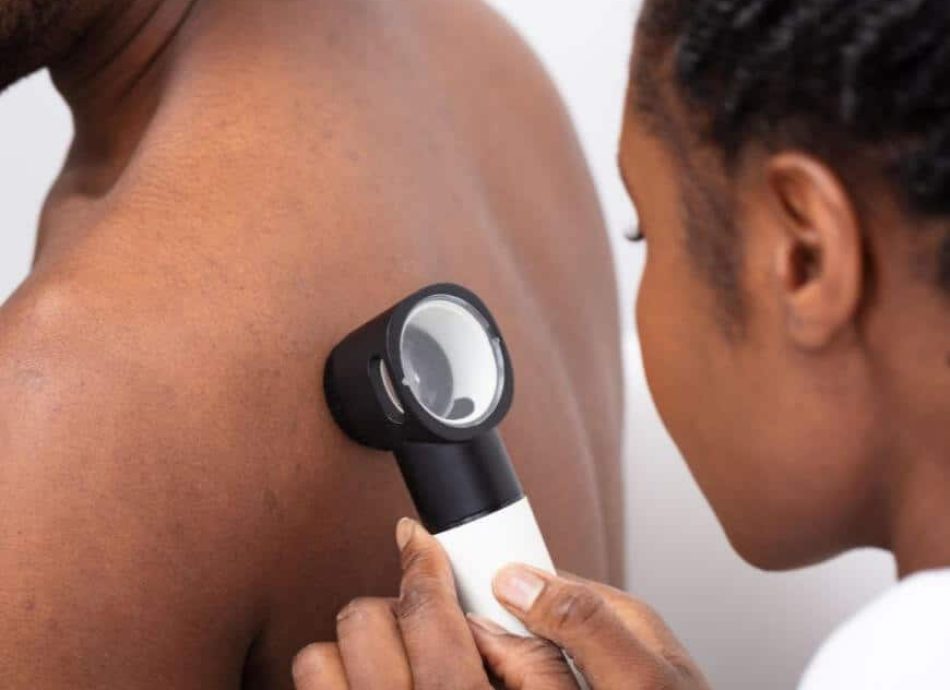
What our Customers Say
Why Treat Your Actinic Keratoses at CANTERBURY SKIN AND LASER CLINIC?
Here at Kent’s leading private skin and laser clinic, our experts are specialists in all aspects of dermatology, skin cancer, anti-ageing and beauty treatments. We are one of the few skin clinics in the UK where all medical consultations and treatments are provided by specialist doctors with Dermatology experience and laser training.
Canterbury Skin and Laser Clinic is regulated by the Care Quality Commission, ensuring the best level of treatment is provided to you in a safe environment. Our Clinical Lead Dr Mark Hudson-Peacock is a member of the British Association of Dermatologists, the British Laser Medical Association, the British Hair and Nail Society, the European Academy of Dermatology and Venereology and is certified by the Consulting Room. We have won many awards including the WhatClinic Patient Service Award in 2019 and the ghp Healthcare and Pharmaceutical Awards 2019.
INSIGHTS AND ADVICE

Safeguard Your Skin – The Comprehensive SPF Guide
Discovering the Power of Sunscreen The SPF label on skincare products might leave you puzzled, especially if you’re a skincare beginner. But worry not, we’ve got you covered. In this comprehensive guide, we’ll explore why SPF is essential for skincare, how to pick the right
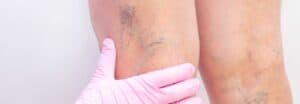
Varicose Veins: Recognising, Managing and Preventing
Varicose veins, with their knotted, engorged appearance, can steal the allure of your legs and cause discomfort. Such veins are common, especially as we age. Unlocking the complexities of varicose veins is essential in managing and reducing their complications. This exhaustive guide unravels the mysteries
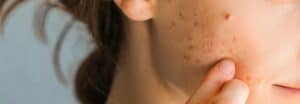
Understanding Acne: A Deep Dive For Acne Awareness Month
Acne Awareness Month is marked globally in June. It’s an opportunity to shed light on one of the world’s most common skin conditions, emphasising the importance of education, support and accessible treatments for those living with acne. Acne Awareness Month seeks to debunk misconceptions, share




